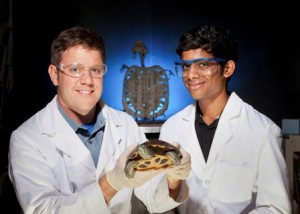
Professor James Dearworth and Brian Selvarajah ’12 are analyzing visual pathways in vertebrates using the turtle as a model.
Even in elementary school, Brian Selvarajah ’12 (Kendall Park, N.J.) saw the living world as an unsolved mystery. Now pursuing a B.S. in biology and an A.B. with a major in international affairs, he is part of cutting-edge research to identify the anatomy underlying the turtle’s response to light.
Selvarajah began as an EXCEL Scholar this past summer and is now preparing independent study research to continue his work. Collaborating with James Dearworth, assistant professor of biology and chair of neuroscience, he is analyzing visual pathways in vertebrates using the turtle as a model. He is attempting to isolate the gene for the photopigment melanopsin, which the team believes is responsible for the sluggish response to light in the pupil of the turtle.
Melanopsin has never before been found in the turtle, but has been shown to play a role in controlling slow pupil response in other animals. Melanopsin is a novel photopigment that is not found in the rods and cones of the eye like the traditional photopigment, rhodopsin, but instead is found in the ganglion cells of the retina and the iris, explains Dearworth. In addition to modulating slow pupil response, the photopigment also is thought to play a role in controlling circadian rhythms. The research could have implications in deciphering why some people have seasonal affective disorder in the winter.
“As a prospective student, I knew I wanted to take part in research,” explains Selvarajah, who plans to work on the project through graduation. “It was one of the major factors in why I applied to Lafayette. Professor Dearworth takes his role as a research professor seriously and strives to pass on knowledge to his students. It is exciting to be part of a team that was the first to locate this gene in the turtle.”
This semester, the team plans to finish sequencing the gene, and Selvarajah is trying to identify the amount of expression of melanopsin in different tissue types. The peer-reviewed journal Vision Research recently accepted one of their manuscripts for publication.
“Brian’s participation has been critical. In addition to carrying out the experiments, he has helped me prepare the manuscripts,” says Dearworth. “He is carrying out roles that at big universities would normally be done by graduate and postdoctoral students and even professors.”
Selvarajah believes his biology research will be a beneficial transition into law school and a career in patent law.
“My research definitely gives me an edge at a time when pharmaceuticals and biotechnology firms are increasing their involvement in the legalities of the life sciences,” he says. “Taking part in complex research will help me in the future when deciphering cases filled with scientific jargon. Not many lawyers have knowledge of advanced molecular techniques.”
For right now, though, Selvarajah is happy to keep unraveling childhood mysteries in the lab.
“There is so much to learn,” he says. “I am always fascinated with the cutting-edge technology and methods I use in the lab. The discoveries of today are not easily achieved but require endless hours in the lab where meticulous work and copious amounts of patience are required.”
